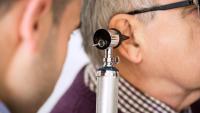Hearing Aids
Make an Appointment
Our team is here to help you make an appointment with the specialists that you need.

ColumbiaDoctors audiologists work closely with patients to improve their hearing. Our audiologists go beyond simply fitting hearing aids to ensure our patients receive maximum benefit and satisfaction from their devices.
What is a Hearing Aid?
Hearing aids use advanced digital technology to help people with hearing loss by improving audibility for sounds they otherwise couldn’t hear. Hearing aids are small, battery-powered devices made of the following basic parts:
- Microphone: receives sound from various directions
- Digital sound processor: processes and adjusts the incoming signals to the wearer’s prescription
- Amplifier: increases the volume of the signals
- Speaker/transducer: reproduces the altered sounds for the listener
Hearing aids are available in many different sizes, styles, and colors. Once a hearing aid is prescribed, it is customized for the user based on the audiogram, sound tolerance, and comfort of the individual.
Choosing the Right Hearing Aid
At ColumbiaDoctors, we view the hearing aid as a rehabilitation device. Our audiologists will help you decide which make, model, and style is best for you by taking into consideration your hearing loss, communication needs, lifestyle, physical abilities, financial concerns, and personal preferences. Audiologists use both evidence-based research and extensive clinical experience to help you make the best choice.
Types of Hearing Aids
There are many types of hearing aids, including the following:
Behind-the-Ear Devices
There are two parts to behind-the-ear devices: one part sits behind the ear and one part goes in the ear canal. A narrow tube or wire connects the two parts.
- Receiver-in-the-canal/Receiver-in-the-ear (RIC/RITE): The components are housed in a case, which is seated behind the ear. The speaker goes in the ear canal and is connected to the device by a tiny wire. The sound is produced directly in the ear canal. A RIC/RITE is cosmetically appealing and can be successfully prescribed for many hearing losses.
- Traditional Behind-the-ear (BTE): These devices provide the most power and connectivity options. A tube hooks over the front of the ear connecting the behind-the-ear piece to a custom made earmold. BTEs are best for people with severe to profound hearing loss. BTE aids are also the preferred choice for young children as they are compatible with FM devices and "grow" with the child.
Custom Devices
Custom-molded hearing aids are formed using 3D printing technology to fit the patient’s ears. Custom devices are recommended depending on the size and shape of the patient’s ear and the demands of the hearing loss. Not all patients can have “invisible” devices when the ear canal is very small or narrow, or when the hearing loss is too severe.
There are several types of custom hearing aids, including:
- Completely-in-the-canal (CIC) is one of the smallest custom products. It provides audibility for adults with mild to moderately severe hearing loss. For some models, a remote control may be used to vary loudness or access internal programs.
- Invisible-in-the-canal (IIC) is the smallest custom hearing aid. It is worn deep in the ear canal, making it virtually invisible. It provides audibility for adults with mild to moderately severe hearing loss.
- In-the-canal (ITC) and In-the-ear (ITE) extends from the ear canal to the ear opening, and into the bottom of the ear entrance above the ear lobe. It can be easier to handle for some people with dexterity concerns and can allow for the addition of specific features, such as volume control or a venting channel. ITC and ITE are suitable for mild to severe hearing loss.
Additional Types of Hearing Aids
Other types of hearing devices include the following:
- Bone anchored hearing devices can be worn using a headband (for children) or can be surgically placed. They work with an external sound processor and use vibrations to transmit sound. This type of device is used to treat conductive and mixed hearing loss, as well as single sided deafness. Bone anchored hearing solutions that are available are Baha, Oticon Ponto, Osia, and Bonebridge.
Hearing Aid Accessories
Hearing aid manufacturers offer accessories that provide solutions for specific challenges to hearing impaired persons. These features are optional and vary depending on the make, model, and level of technology of the hearing aid. Features include wireless interface with Bluetooth-compatible devices such as cellphones and televisions, rechargeable batteries, remote controls, telecoils for listening in equipped public venues, environmental noise control, directional microphones, and variable programming. Our audiologists recommend features suitable to each patient’s particular hearing needs.
Cost
While some insurance plans help cover the cost of hearing aids, many others, including Medicare, have no hearing aid benefit at all. Our audiologists present fitting options with your budget in mind while striving to maintain a high standard of care. We encourage our patients to learn about their insurance plan benefits and exclusions.
If a patient has hearing aids that were purchased at another facility, our audiologists are available to program, troubleshoot, and help ensure that patients are getting the most benefit from their hearing devices.